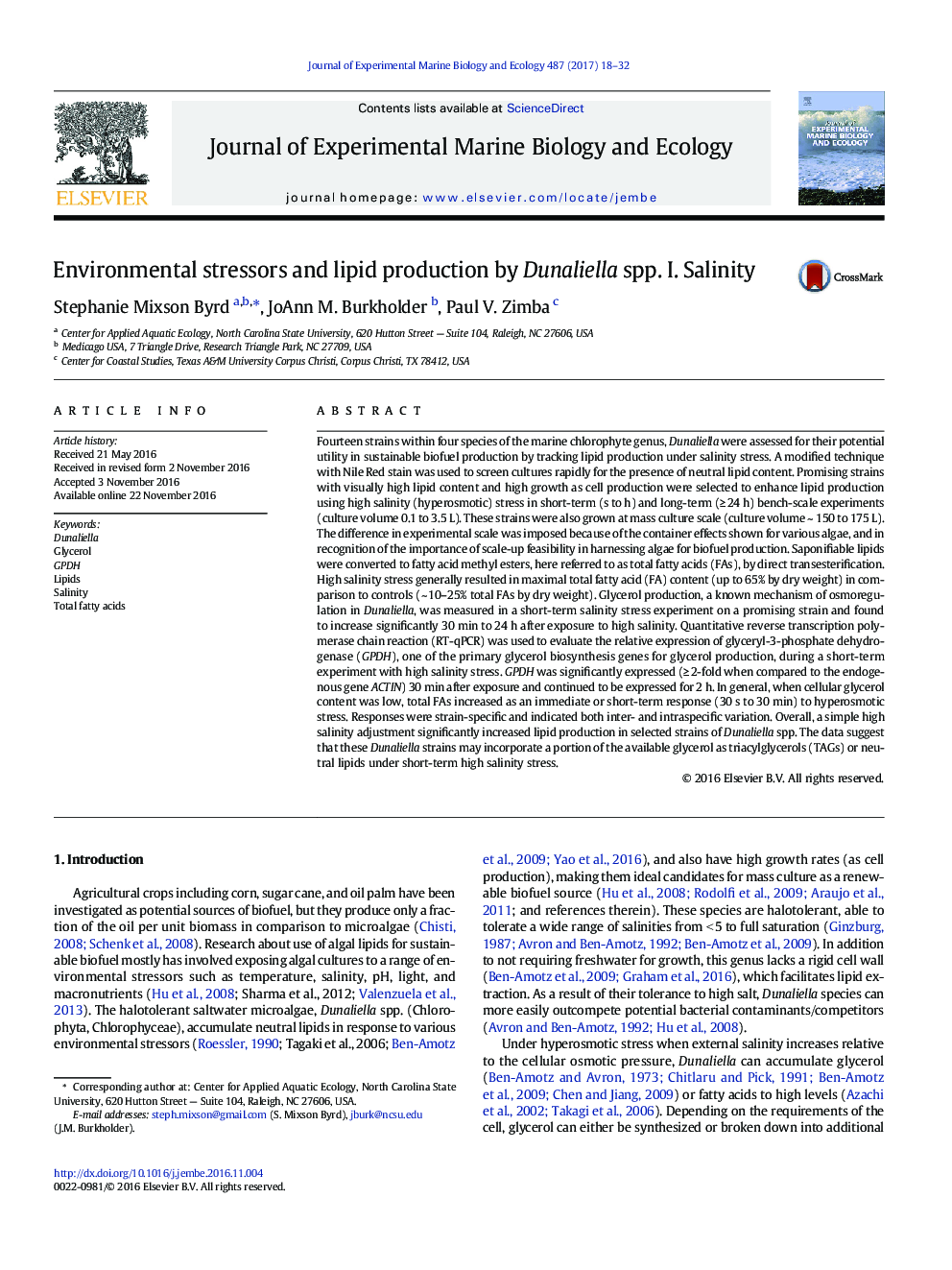| کد مقاله | کد نشریه | سال انتشار | مقاله انگلیسی | نسخه تمام متن |
|---|---|---|---|---|
| 5744576 | 1618388 | 2017 | 15 صفحه PDF | دانلود رایگان |

- We assessed 14 strains within four species of the marine chlorophyte genus, Dunaliella for their potential utility in sustainable biofuel production by tracking lipid production under salinity stress.
- High salinity stress generally resulted in maximal total fatty acid (FA) content (up to 65% by dry weight) in comparison to controls (~Â 10-25% total FAs by dry weight). The unique strain, Dunaliella viridis UTEX ZZ1150, was most promising for lipid production because it produced high amounts of lipids throughout its growth cycle.
- Glycerol production increased significantly 30Â min to 24Â h after exposure to high salinity, depending on the strain, and a primary glycerol biosynthesis gene, glyceryl-3-phosphate dehydrogenase (GDPH), was significantly expressed 30Â min after exposure and continued to be expressed for 24Â h.
- Glycerol apparently acted not only as an osmolyte during hyperosmotic stress, but also provided the carbon structure to which fatty acids were covalently linked to form neutral lipids.
Fourteen strains within four species of the marine chlorophyte genus, Dunaliella were assessed for their potential utility in sustainable biofuel production by tracking lipid production under salinity stress. A modified technique with Nile Red stain was used to screen cultures rapidly for the presence of neutral lipid content. Promising strains with visually high lipid content and high growth as cell production were selected to enhance lipid production using high salinity (hyperosmotic) stress in short-term (s to h) and long-term (â¥Â 24 h) bench-scale experiments (culture volume 0.1 to 3.5 L). These strains were also grown at mass culture scale (culture volume ~ 150 to 175 L). The difference in experimental scale was imposed because of the container effects shown for various algae, and in recognition of the importance of scale-up feasibility in harnessing algae for biofuel production. Saponifiable lipids were converted to fatty acid methyl esters, here referred to as total fatty acids (FAs), by direct transesterification. High salinity stress generally resulted in maximal total fatty acid (FA) content (up to 65% by dry weight) in comparison to controls (~ 10-25% total FAs by dry weight). Glycerol production, a known mechanism of osmoregulation in Dunaliella, was measured in a short-term salinity stress experiment on a promising strain and found to increase significantly 30 min to 24 h after exposure to high salinity. Quantitative reverse transcription polymerase chain reaction (RT-qPCR) was used to evaluate the relative expression of glyceryl-3-phosphate dehydrogenase (GPDH), one of the primary glycerol biosynthesis genes for glycerol production, during a short-term experiment with high salinity stress. GPDH was significantly expressed (â¥Â 2-fold when compared to the endogenous gene ACTIN) 30 min after exposure and continued to be expressed for 2 h. In general, when cellular glycerol content was low, total FAs increased as an immediate or short-term response (30 s to 30 min) to hyperosmotic stress. Responses were strain-specific and indicated both inter- and intraspecific variation. Overall, a simple high salinity adjustment significantly increased lipid production in selected strains of Dunaliella spp. The data suggest that these Dunaliella strains may incorporate a portion of the available glycerol as triacylglycerols (TAGs) or neutral lipids under short-term high salinity stress.
Journal: Journal of Experimental Marine Biology and Ecology - Volume 487, February 2017, Pages 18-32